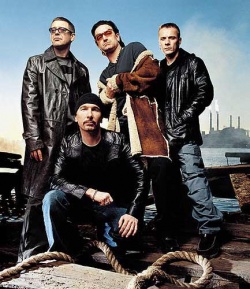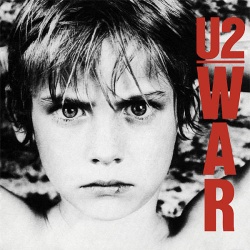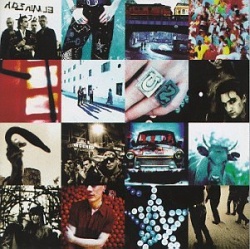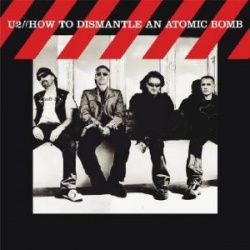U2
U2 is an Irish formed rock funk dance band. They are a four man band with Bono as lead singer, The Edge as guitarist, Mullen as drummer and Clayton on bass. They have won several Grammy awards and have released several albums.
Contents |
Timeline
Formation and start-up
U2 was formed in Dublin in Sptember 19769. Larry Mullen Jr, who was 14 at the time, posted a notice on his school’s notice board. He said he was seeking members for a band. Seven boys attended to the audition in Mullen’s kitchen. Mullen has later said that the first ten minutes, it was his band, but from the moment Bono stepped, it was Bono’s. The group now had the members Paul Hewson (Bono) on lead vocals, Dave Evans (The Edge) and his brother Dick on guitar, Adam Clayton on bass. The group called themselves Feedback and played mostly covers.
In March 1977, the band changed their name to “The Hype.” Dick Evans, was “phased” out of the band, because he was a bit of an outsider; he was the oldest and he already went to college. During a farewell concert in a church hall in Howth, The Hype were playing covers and Dick walked of stage in a very noble way. The remaining of the band played their original material such ass “U2”. Friend of the Clayton family and punk rock musician, Steve Averill had suggested The Hype six names, and the band chose U2 because it for it’s open interpretations.
On Saint Patrick’s Day in ’78, U2 won the CBS competition in Limerick, Ireland. The prize they earned was 500 pounds and the funds to record a demo, which was important for a starting band. U2 recorded their demo at the Keystone studio. Later that year, in March, Paul McGuinness agreed to be U2’s manager. In September 1979, U2’s first EP was released (Ireland only) and called Three. In December ’79 U2 performed in London for their first international show, but they didn’t get much attention. In February ’80 their second single was released and also this time it was only released in Ireland. It was called Another Day and it was released under CBS.
Boy and October
In March and May 1980, U2 had their first internationally released single and signed for a contract with Island Records. The single was called 11 O’clock Tick Tock. The band also had their debut album produced, called Boy. Later followed their second album called October. The album included their first UK hit, I will Follow. When Boy was released, U2 went on their first European and American tour. Their live performances showed that U2 was a band with potential. The band’s second album, October, was released in 1981 and contained a lot of spiritual themes. The Edge, Bono and Mulland had joined a Christian group called Shalom Fellowship and now searched for the connection between the Christian faith and the Rock and Roll lifestyle. The album didn’t sell very well outside the UK and it wasn’t as much on the radio as they hoped. Island Records putted some pressure on U2, they had to improve.
War
In 1983, U2 Released War, which resolved all the doubts. The musical style was a sincere and some called it “rugged” which contrasted with the popular music of that time, which was the cooler synth-pop. The album contained “Sunday Bloody Sunday”, which was about the bloody Sunday in Ireland in 1972 where Irish people died. War was also the first U2 album with photographs from Anton Corbijn, who remained, and still remains, their principal photographer. War debuted at number one in the UK and it’s single New Year’s Day became their first overseas hit. The band also had a War Tour where they performed to sold-out concerts in the mainland of Europe and in the U.S. While playing Sunday bloody Sunday, Bono waved a white flag, which became a familiar sight. On this tour, U2 also recorded their live album Under a Blood Red Sky, which also came with a live video. MTV and the radio played the album extensively and U2 got a wider audience. They also lengthened their record deal with Island Recoreds with a very lucrative extension. They got the return of their copyrights and had an increased royalty raise.
The Unforgettable Fire
In 1984, U2 released Fire. The band was changing in musical direction, and this album showed that. U2 feared that they would become another “shrill”, “sloganeering arena-rock band”. Adam Clayton remembers that they were experimenting with styles, they wanted something more serious and more artistic. The Unforgettable Fire was directed and produced by Daniel Lanois, who helped Mullen to get a looser drum style and Clayton a more subliminal bass style. Now the rhythm work in the songs was better and gave the songs a more dynamic feeling. Also the lyrics are very open to different interpretations and gave, what the band called, a visual feel. The recording schedules were tight, and Bono felt like some songs were incomplete. Pride (In the Name of Love) became U2’s biggest hit and their first to enter the US top 40.
Live Aid
U2 participated in the Live Aid concert for Ethiopian famine relief at Wembley Stadium in July 1985. The performance was a very memorable one, and it was said as being a turning point in the band members career. During the song “Bad”, Bono jumped of the stage to embrace and dance with a fan. Critics and the audience described this as an example of how good the connection between Bono and the fans was. In1985 The Rolling Stone magazine said that U2 was the best band of the eighties. They said that for a lot of rock’n’roll fans, U2 had became the band that mattered most, maybe even the only band that mattered.
The Joshua Tree
The Joshua Tree was released in 1987. Bono had had a lot of inspiration by his trips to San Salvador and Nicaragua where he saw the conflicts between the American political intervention and the peasants. The album became the fastest-selling album in the British chart history and kept their number one place for nine weeks in the U.S. U2 also got their first two Grammy Awards for The Joshua Tree. Two of the songs form the album, With or Without You and I Still haven’t Found What I’m Looking For, went straight to the top and topped at number one on the U.S. charts. The Joshua Tree tour was the first tour where the band played in numerous stadiums, alongside smaller arena shows.
Rattle and Hum
Rattle and Hum was the name of a documentary, as well as the name of U2’s next album. The documentary featured footage recorded during The Joshua Tree Tour and the album was a double album with nine studio tracks and six live performances. The album and the film were intended as a tribute to American music, and it was released in record stores and in cinemas in October 1988. Both film and music critics gave mixed reviews, but the fans gave a positive reception. The film included recording reviews at the Sun Studios in Memphis and tracks with Bob Dylan and B.B. King. U2 played most of the new material on 1989’s Lovetown Tour, which was mainly held in Australia and Europe.
Achtung Baby
In November 1991, U2 released their seventh studio album called Achtung Baby. The band had listened to the critics on Rattle and Hum and changed their musical and lyrical direction. The album contains Dance, industrial and alternative music influences and the band referred to the album as the sound of “four men chopping down the Joshua Tree”. This album contained more of the dark sphere then all the previous albums and this album was one of the band’s most successful albums was crucial in the rebirth of U2. The band worked on Achtung Baby in East Berlin, where they hoped to find inspiration. The album was produced by Daniel Lanois again, with the assistance of Brian Eno. The band did have some conflicts about the musical direction. Bono and The Edge were fascinated by the alternative and European dance music, while Mullen and Clayton wanted to stick with U2’s old style. There also was a lot of rallying about the song One, that Edge had created. Later One was released and also played as a duet with Mary J. Blige.
Zoo TV Tour and Zooropa
The Zoo TV Tour of 1992-1993 was a multimedia event and showcased an extravagant chaotic array of hundreds of video screens, trabant cars, satellite TV links and Bono’s overdone stage characters like “The Fly”, “Mirror-Ball Man” and “MacPhisto”. The show was intended to contrast the serious performances U2 had given on previous tours. Also during this tour, a quickly recorded album was made: Zooropa. It was released in the summer of 1993. It was intended as an EP, but ended as a full-length LP album. This album even got the further away from their early style, and included some techno influences in their music. At the last song they played from Zooropa on the Zoo TV Tour, Bono stepped aside from the microphone and let Johnny Cash perform.
Pop
In 1997, U2 released another album: Pop. It again was a very experimental album containing loops, programming, rhythm sequencing and sampling. The album contained much heavy, funky dance rhythms. The album was released in March and debuted at numer one in 35 countries. The album got a lot of good reviews and again Rolling Stone gave U2 very positive comments. Unless the good reviews, others felt like this album was less good then the earlier ones. Also the sales were poor compared to the previous releases. Bono later admitted that the album wasn’t as good as they intended to, a reason for this can be that they had to hurry into completing the album for the pre-booked tour. This was held in 1997 and called PopMart. The stage was a bit like the Zoo TV Tour and the it featured a lot of advertisement as an ironic message to everyone who said that U2 was to commercialized. A highlight of the tour was a concert in Sarajevo where U2 was the first big band that performed after the Bosnian War. The members of U2 found it a very memorable performance and Mullen said that if he had to spend 20 years to play that show, he would have done it. U2 also appeared in the 200th episode of The Simpsons, where Homer Simpson walks up the stage and interrupts U2 while they are playing their PopMart tour.
2000-present
In October 2000 U2 released a new album named All That You Can’t Leave Behind. It reunited the band with Brian Eno and Daniel Lanois, their producers. This album earned quit some Grammy Awards: the song Beautiful Day earned three Grammies and the singles Walk On, Elevation and Stuck in a Moment You Can’t Get Out Of also won Grammy Awards. The album reached number one in 22 countries.
For the Elevation Tour, U2 performed on a smaller setting then they had done before. They returned to the arenas, after a lot of stadium productions. In October 2001, U2 performed a series of out-sold performances at Madison Square Garden in New York City and in inerviews, Bono and The Edge later said that they saw these shows as their most memorable and emotional performances. In 2002 U2 also performed during the halftime of the Super Bowl XXXVI, which is an American football game.
The band’s next studio album was named How to Dismantle an Atomic bomb and was released in November 2004. The band said they were looking for harder rock then they had made on All That You Can’t Leave Behind. The first song on he album, Vertigo, was also featured on a TV commercial for the Apple Ipod. A special U2 Ipod was released, together with an iTunes U2 Box Set. The album set a record for the band, with twice as much first-week sales then All That You Can’t Leave Behind and debuting on the first place in the U.S. charts. The one thing Bono wasn’t happy about is that all the songs were great, but as an album it didn’t have any extra value, he stated “There are no weak songs. But as an album, the whole isn’t greater than the sum of its parts, and it f*cking annoys me.”
There came a Vertigo Tour, and during nine shows of that tour, a 3-d film was made : U2 3D. The film was released on March 31, 2008. It has also been confirmed that U2 has signed a deal with Live Nation. Live Nation now has the control over the band’s merchandise, sponsoring and their website.
Style
U2 has developed it’s own recognizable style. The Edge has always used his rhythmic patterns and a signature delay. U2 hasn’t always had the same style, but they developed. In the start, the sounds were more punk like, and later they became more rock and dance like. In the nignties, U2 “reinvented” themselves and started using synthesizers, distortion and electronics to get a more alternative style. In the new century, U2 started playing more back to basic, with less computerized music.
Discography
U2 albums:
1980 - Boy
1981 - October
1983 - War
1984 - The Unforgettable Fire
1987 - The Joshua Tree
1988 - Rattle and Hum
1991 - Achtung Baby
1993 - Zooropa
1997 - Pop
2000 - All That You Can't Leave Behind
2004 - How to Dismantle an Atomic Bomb









